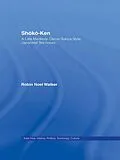First published in 2003. Built in 1628 at the Koto-in temple in the precincts of Daitoku-ji monastery in Kyoto, the Shoko-ken is a late medieval daime sukiya Japanese tea-house. It is attributed to Hosokawa Tadaoki, also known as Hosokawa Sansai, an aristocrat and daimyo military leader, and a disciple and friend of Sen no Riky?. This work is an extremely thorough look at one of the few remaining tea-houses of the Momoyama era tea-masters who studied with Sen no Rikyu. The English language sources on Hosokawa Sansai and his tea-houses have been exhaustively researched. Many facts and minute observations have been brought together to give even the reader unfamiliar with Tea a sense of the presence which the tea-house still manifests.
Autorentext
Robin Noel Walker
Zusammenfassung
First published in 2003. Routledge is an imprint of Taylor & Francis, an informa company.
Inhalt
1.0 Introduction; 1.1 Background to the Study; 1.11 Hosokawa Tadaoki - Hosokawa Sansai; 1.12 Shoko-ken and Hosokawa Sansai's other tea houses; 1.13 Textural Resource - representations of sukiya architecture; 1.131 Early Europeans; 1.132 Modernist Architects; 1.133 Tea Proponents;; 1.2 Terms of the 'face'; 1.21 Sukiya; 1.22 Konomi; 1.23 Furyu; 1.24 Sakui; 1.3 Measuring the 'face'; 1.31 Authenticity; 1.32 Measured Drawing; 2.0 Internal Architecture; 2.1 Zashiki; 2.11 Layout; 2.12 Spatial Organisation; 2.13 Components, Materials, Finishes; 2.2 Tsugi-no ma; 2.3 Katte; 3.0 External Architecture; 4.0 Inner Garden; 5.0 Outer Garden; 6.0 Conclusion
